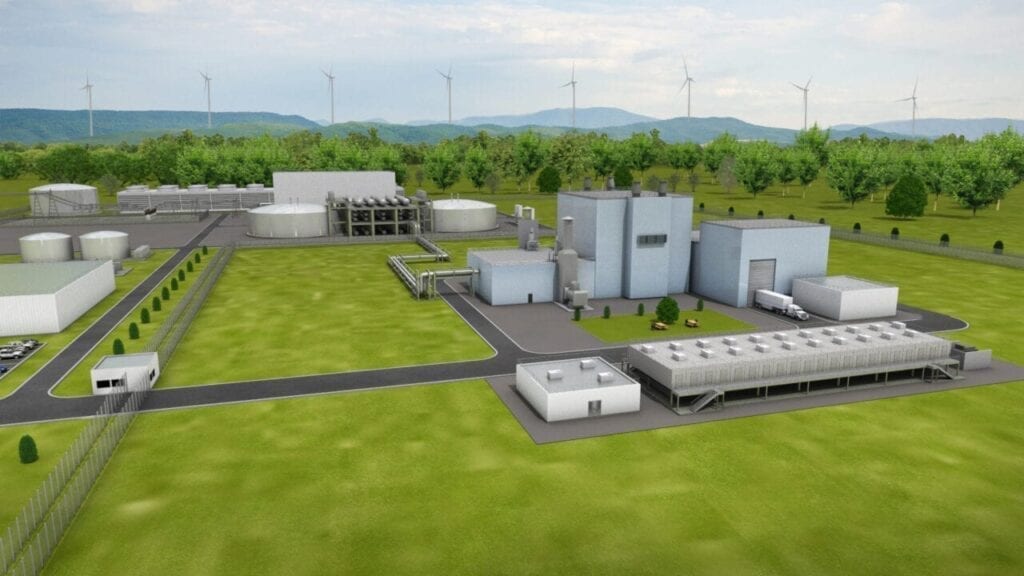Bill Gates' TerraPower Ready to Build New U.S. Nuclear Power Plant
A group established by Microsoft founder Bill Gates is preparing to begin construction of a new generation of nuclear power plants in June, according to the company’s chief executive.
Chris Levesque, CEO of TerraPower, on March 18 said the company is ready to move forward with work on its Natrium reactor at the site of a former coal-fired power plant in Kemmerer, Wyoming. The group has received about $1 billion in private funding, with the U.S. government reportedly supporting the Wyoming project with as much as $2 billion.
TerraPower on March 29 confirmed that it has submitted its construction permit application to the U.S. Nuclear Regulatory Commission (NRC). The company is the first to submit such an application for a commercial advanced reactor to the NRC.
Levesque told the Financial Times newspaper that construction work for the power plant would start in June, even if the company has not received a permit from the U.S. Nuclear Regulatory Commission (NRC). Levesque said much of the early work would not be related to nuclear activity, but rather to the design of the reactor. He said TerraPower hopes to have the plant enter commercial operation in 2030.
Liquid Sodium as Coolant
The Natrium reactor design will use liquid sodium as a coolant instead of water. Levesque told the Financial Times, “When you use liquid sodium as a coolant instead of water it’s a game-changer. Natrium plants will cost half of what light water reactor plants cost . . . and we are moving our project along pretty aggressively.”
Levesque has said the high boiling point of almost 900C for the liquid metal would bring major cost savings compared with using water.

U.S. utility Southern Co. in November of last year said it had agreed to design and build an advanced demonstration nuclear reactor at Idaho National Laboratory (INL) using technology developed by TerraPower. Southern said it would build a molten-chloride reactor at INL. The U.S. Dept. of Energy (DOE) has said it would provide a five-year grant to cover 80% of the $170 million project at INL, with the rest coming from Southern, TerraPower, and other investors.
Southern Co. and TerraPower were awarded about $40 million from DOE through a public-private partnership in 2015. The money was earmarked for construction of integrated infrastructure necessary to support early development of molten chloride fast reactor, or MCFR, technology.
TerraPower in December of last year signed an agreement with Emirates Nuclear Energy Corp. That deal is designed for TerraPower to explore not only the use of its Natrium reactors to generate electricity in the United Arab Emirates, but also to produce hydrogen.
Small Reactors
TerraPower is among several groups working on a new generation of small nuclear reactors, including micro-reactors and small modular reactors (SMRs). Most of the SMRs in development would have a generation capacity of 300 MW or less. Most newer utility-scale reactors can generate 1,000 MW of power or more, such as the two units that recently entered commercial operation at Plant Vogtle in Georgia as part of an expansion there.
Energy analysts have told POWER that large-scale deployment of SMRs faces several challenges, both economic and regulatory as well as technical. Most are in agreement that government support will be needed to support new projects.
An example of the challenges is provided by Oregon-based NuScale. The company was dealt a blow to its operations with the November 2023 cancellation of a flagship project the group had planned with Utah Associated Municipal Power Systems. NuScale, founded in 2007, was the first U.S.-based SMR maker with NRC approval for its technology. The company reduced its workforce earlier this year as part of a restructuring.
There are just two SMRs deployed to date worldwide. Russia has a floating power plant, using a KLT-40S, a pressurized water reactor developed in that country. Those units are on board the Akademik Lomonosov, which is the world’s first purpose-built floating nuclear power plant.
China National Nuclear Corp. in December of last year said it had started commercial operation of the high-temperature gas-cooled modular pebble bed (HTR-PM) reactor demonstrator. The HTR-PM project is located in Rongcheng, Shandong Province, about midway between Beijing and Shanghai in eastern China.
The HTR-PM is touted as the world’s first commercially operational modular nuclear power plant with fourth-generation nuclear technology.
Demonstration Project
TerraPower has said the Kemmerer reactor would serve as a demonstration project, eventually serving as a full-scale commercial facility once complete. TerraPower and utility partner PacifiCorp, which is part of Warren Buffett’s Berkshire Hathaway, in October 2022 said the companies could deploy as many as five Natrium reactors by 2035, if the technology proves feasible.
The Natrium reactor, which has been developed by TerraPower along with GE Hitachi Nuclear Energy, is a bit larger than most SMRs, with a generation capacity of 345 MW. The reactor also includes a molten salt-based energy storage system (ESS). TerraPower has said the ESS could increase the power output to 500 MW for a period of more than five-and-a-half hours if needed.
Levesque said, “We’re storing the heat in big tanks of molten salt, like solar plants, and that’s a big thermal battery. A plant like Natrium that can just flex very quickly with that built-in energy storage makes it very valuable.”
—Darrell Proctor is a senior associate editor for POWER (@POWERmagazine).